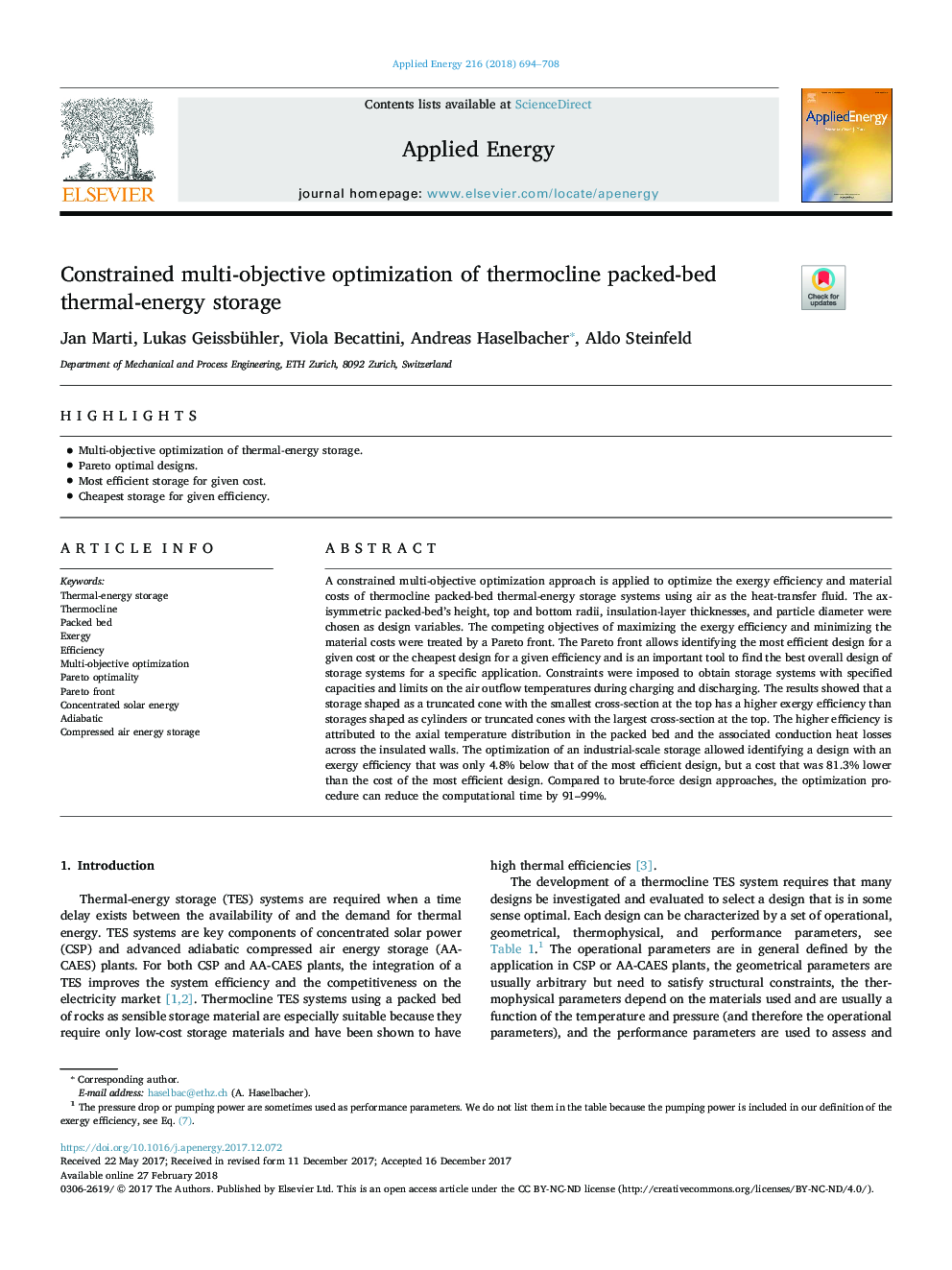| کد مقاله | کد نشریه | سال انتشار | مقاله انگلیسی | نسخه تمام متن |
|---|---|---|---|---|
| 6680642 | 1428074 | 2018 | 15 صفحه PDF | دانلود رایگان |
عنوان انگلیسی مقاله ISI
Constrained multi-objective optimization of thermocline packed-bed thermal-energy storage
ترجمه فارسی عنوان
بهینه سازی چند هدفه محدودیت ذخیره سازی حرارتی ترموکلینل بسته بندی شده تخت
دانلود مقاله + سفارش ترجمه
دانلود مقاله ISI انگلیسی
رایگان برای ایرانیان
کلمات کلیدی
ذخیره انرژی حرارتی، ترموکلاین، تخت بسته بندی شده، اگزرژی، بهره وری، بهینه سازی چند هدفه، بهینه سازی پارتو، پارتو جلو، انرژی خورشیدی غنی شده، آدیاباتیک، ذخیره انرژی فشرده،
Adiabatic - آدیاباتیکConcentrated solar energy - انرژی خورشیدی غنی شدهExergy - اکسرژیEfficiency - بازده Packed bed - بستر آکندهPareto optimality - بهینه سازی پارتوMulti-objective optimization - بهینه سازی چند هدفهThermocline - ترموکلاینThermal-energy storage - ذخیره انرژی حرارتیCompressed air energy storage - ذخیره انرژی هوا فشردهPareto front - قسمت پارتو
ترجمه چکیده
رویکرد بهینه سازی چند هدفه ای محدود برای بهینه سازی کارایی اگزرژی و هزینه های مادونات سیستم های ذخیره انرژی حرارتی بسته بندی شده بستر حرارتی با استفاده از هوا به عنوان مایع انتقال حرارت استفاده می شود. ارتفاع محدوده بسته بندی شده محور، شعاع بالا و پایین، ضخامت عایق لایه و قطر ذرات به عنوان متغیرهای طراحی انتخاب شدند. اهداف رقابت برای به حداکثر رساندن کارایی اگزرژی و به حداقل رساندن هزینه های مواد توسط یک جبهه پارتو تحت درمان قرار گرفتند. جبهه پارتو اجازه می دهد تا شناسایی کارآمدترین طراحی برای یک هزینه معین یا ارزان ترین طراحی برای یک کارایی مشخص و یک ابزار مهم برای یافتن بهترین طراحی کلی سیستم های ذخیره سازی برای یک برنامه خاص باشد. محدودیت ها برای دستیابی به سیستم های ذخیره سازی با ظرفیت مشخص شده و محدودیت های دمای خروج هوا در هنگام شارژ و تخلیه تحمیل شد. نتایج نشان داد که ذخیره سازی به شکل یک مخروط کوتاه که دارای کوچکترین مقطع در بالای صفحه است، دارای کارایی بالاتری نسبت به سیلندرها یا مخروط های کوتاه شده با بزرگترین مقطع در بالای صفحه است. راندمان بالاتر نسبت به توزیع درجه حرارت محوری در بستر بسته بندی شده و تلفات حرارت هدایت شده در دیواره های عایق بندی شده است. بهینه سازی ذخیره سازی در مقیاس صنعتی اجازه می دهد تا شناسایی طراحی با بهره وری اضافی که فقط 4.8٪ کمتر از طراحی کارآمد است، اما هزینه ای که 81.3٪ کمتر از هزینه های کارآمد ترین طراحی بود. در مقایسه با رویکرد طراحی نیروی بی رحم، روش بهینه سازی می تواند زمان محاسبات را با 91 تا 99 درصد کاهش دهد.
موضوعات مرتبط
مهندسی و علوم پایه
مهندسی انرژی
مهندسی انرژی و فناوری های برق
چکیده انگلیسی
A constrained multi-objective optimization approach is applied to optimize the exergy efficiency and material costs of thermocline packed-bed thermal-energy storage systems using air as the heat-transfer fluid. The axisymmetric packed-bed's height, top and bottom radii, insulation-layer thicknesses, and particle diameter were chosen as design variables. The competing objectives of maximizing the exergy efficiency and minimizing the material costs were treated by a Pareto front. The Pareto front allows identifying the most efficient design for a given cost or the cheapest design for a given efficiency and is an important tool to find the best overall design of storage systems for a specific application. Constraints were imposed to obtain storage systems with specified capacities and limits on the air outflow temperatures during charging and discharging. The results showed that a storage shaped as a truncated cone with the smallest cross-section at the top has a higher exergy efficiency than storages shaped as cylinders or truncated cones with the largest cross-section at the top. The higher efficiency is attributed to the axial temperature distribution in the packed bed and the associated conduction heat losses across the insulated walls. The optimization of an industrial-scale storage allowed identifying a design with an exergy efficiency that was only 4.8% below that of the most efficient design, but a cost that was 81.3% lower than the cost of the most efficient design. Compared to brute-force design approaches, the optimization procedure can reduce the computational time by 91-99%.
ناشر
Database: Elsevier - ScienceDirect (ساینس دایرکت)
Journal: Applied Energy - Volume 216, 15 April 2018, Pages 694-708
Journal: Applied Energy - Volume 216, 15 April 2018, Pages 694-708
نویسندگان
Jan Marti, Lukas Geissbühler, Viola Becattini, Andreas Haselbacher, Aldo Steinfeld,
